The Intel Optane Memory M10 (64GB) Review: Optane Caching Refreshed
by Billy Tallis on May 15, 2018 10:45 AM EST- Posted in
- SSDs
- Storage
- Intel
- PCIe SSD
- SSD Caching
- M.2
- NVMe
- Optane
- Optane Memory
BAPCo SYSmark 2014 SE
BAPCo's SYSmark 2014 SE is an application-based benchmark that uses real-world applications to replay usage patterns of business users in the areas of office productivity, media creation and data/financial analysis. In addition, it also addresses the responsiveness aspect which deals with user experience as related to application and file launches, multi-tasking etc. Scores are calibrated against a reference system that is defined to score 1000 in each of the scenarios. A score of, say, 2000, would imply that the system under test is twice as fast as the reference system.
SYSmark scores are based on total application response time as seen by the user, including not only storage latency but time spent by the processor. This means there's a limit to how much a storage improvement could possibly increase scores, because the SSD is only in use for a small fraction of the total test duration. This is a significant difference from our ATSB tests where only the storage portion of the workload is replicated and disk idle times are cut short to a maximum of 25ms.
For this review, SYSmark has been used on two different machines: a relatively high-end system with a six-core Intel Core i7-8700K processor and 16GB of RAM, and a more limited system with a quad-core Intel Core i5-7400 processor and just 4GB of RAM. The low-end system spends a lot of time swapping thanks to its small amount of RAM, and this adds greatly to the storage workload.
| AnandTech SYSmark SSD Testbed | |
| CPU | Intel Core i7-8700K |
| Motherboard | Gigabyte Aorus H370 Gaming 3 WiFi |
| Chipset | Intel H370 |
| Memory | 2x 8GB Kingston DDR4-2666 |
| Case | In Win C583 |
| Power Supply | Cooler Master G550M |
| OS | Windows 10 64-bit, version 1709 |
| AnandTech SYSmark SSD Low-End Testbed | |
| CPU | Intel Core i5-7400 |
| Motherboard | ASUS PRIME Z270-A |
| Chipset | Intel Z270 |
| Memory | 1x 4GB Corsair DDR4-2666 |
| Case | In Win C583 |
| Power Supply | Cooler Master G550M |
| OS | Windows 10 64-bit, version 1709 |
None of the Optane Memory modules are large enough to serve as a Windows boot drive alone as well as storing all the applications used for SYSmark, so this section only tests the Optane Memory and Optane SSD 800P as cache drives. (The 118GB Optane SSD 800P is pretty much the smallest drive that can could run SYSmark, but it doesn't leave much room for user data.)
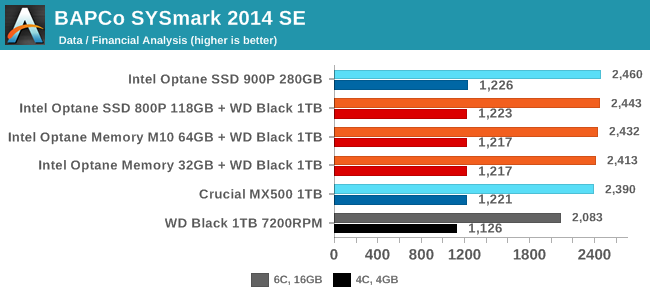
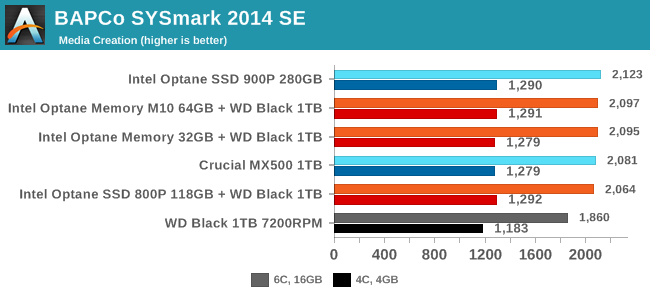
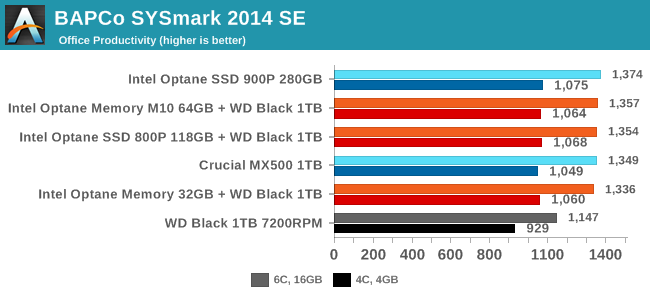
The Data/Financial Analysis, Media Creation, and Office Productivity sub-tests are all relatively insensitive to storage performance, and they are shown in order of decreasing sensitivity to the CPU and RAM differences between the two test systems. These results show that a mechanical hard drive can hold back application performance, but almost any solid state storage system—including Optane Memory caching—is sufficient to shift the bottlenecks over to compute and memory.
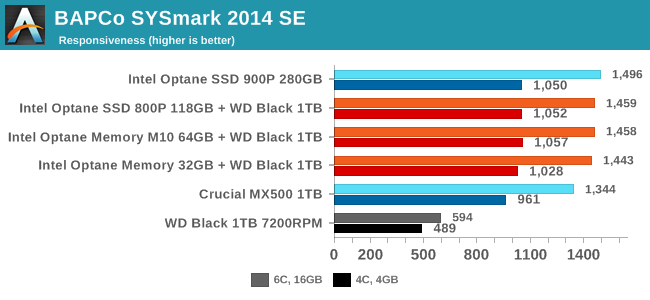
The Responsiveness test is less focused on overall computational throughput and more on those annoying delays that make a computer feel slow: application launching, opening and saving files, and a variety of multitasking scenarios. Here, moving off a mechanical hard drive is by far the best upgrade that can be made to improve system performance. Going beyond a mainstream SATA SSD provides diminishing returns, but there is a measurable difference between the SATA SSD and the fastest Optane SSD.
Energy Usage
The SYSmark energy usage scores measure total system power consumption, excluding the display. Our SYSmark test system idles at around 26 W and peaks at over 60 W measured at the wall during the benchmark run. SATA SSDs seldom exceed 5 W and idle at a fraction of a watt, and the SSDs spend most of the test idle. This means the energy usage scores will inevitably be very close. A typical notebook system will tend to be better optimized for power efficiency than this desktop system, so the SSD would account for a much larger portion of the total and the score difference between SSDs would be more noticeable.
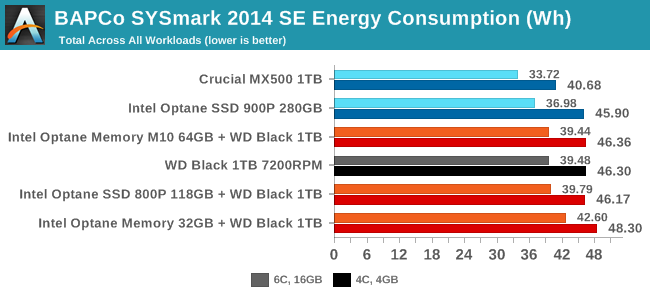
The Intel Optane SSD 900P is quite power-hungry by SSD standards, but running a hard drive is even worse. The Optane Memory M10 and 118GB 800P further add to power consumption when used as cache devices, but they speed up the test enough that total energy usage is not significantly affected. The 32GB Optane Memory doesn't offer as much of a performance boost, and it lacks the power management capabilities of the more recent Optane M.2 drives.










96 Comments
View All Comments
Flunk - Tuesday, May 15, 2018 - link
For $144 you can get a 256GB M.2 SSD, big enough to use as a boot drive. Even as a cache for a slow hard-drive (which means you also need to buy a hard drive, possibly bumping the cost up to 512GB SSD prices) means this product doesn't make any sense at all. Maybe it made sense when they started development, but it doesn't now.dullard - Tuesday, May 15, 2018 - link
Flunk, the reason to get these drives is that an Optane cache + standard hard drive is FASTER and LARGER CAPACITY than the 512 GB SSD. If you don't like larger or faster, then go ahead with just a SSD.bananaforscale - Tuesday, May 15, 2018 - link
You totally miss the point. An SSD is cheaper and irrelevantly slower and you can use it for caching.wumpus - Wednesday, May 16, 2018 - link
You can? You used to be able to use a 64GB cache on Intel boards, and you can use a 512GB cache on just released AMD (470) boards [unfortunately, that bit of the review still has [words] under the storeMI section].If you can pull it off, a 512GB caching SATA drive makes all kinds of sense for anything you might want to do with this. As near as I can tell, Optane's only advantage is that they provide the caching software without having to hit windows and motherboard requirements. Which makes the whole "optane is so fast" advantage a bit of a joke.
Wake me up when optane has the endurance to be used with a DDR4 interface (presumably with caching HBM2/Intel system DRAM). This doesn't give any advantage (besides providing the software license).
shadowx360 - Wednesday, May 23, 2018 - link
Windows Storage Spaces or ZFS can do it. Right now I have 2x256GB SSDs mirrored to accelerate a 5x4TB hard drive array. I set 100GB as a write-back cache that automatically flushes to the HDDs, so random write is SSD-level quick. I also pin about 20GB of files to the SSDs permanently and the rest is rotated between free space and system-managed hot files.Lolimaster - Tuesday, May 15, 2018 - link
400-500MB/s vs 1.5GB/s, not really much of a difference, either way you will have to wait for that HDD to write to the cache drive 1st at 100MB/s or less (since they're small files, HDD works faster on transfer with larger files).If you got a set of constantly used files, move those to the SSD, problem solved.
evernessince - Wednesday, May 16, 2018 - link
Or you buy an X470 motherboard or pay $10 to get StoreMI, which also makes a cache but is much cheaper and can use any SSD as a cache, which saves you money, allot of it.CheapSushi - Wednesday, May 16, 2018 - link
You can use any Optane drive like ANY SSD too.Spunjji - Wednesday, May 16, 2018 - link
It's faster in zero real-world situations. It's larger than an SSD bought for the same total money, but not larger than an SSD at the same cost as the optane drive (256GB) + the same HDD you'd use for optane caching. Your point is... flawed.Keljian - Tuesday, May 29, 2018 - link
This is actually not true. It's faster for Mysql/sqlite in 4k situations when the cache is tuned for it. What uses sqlite? - games, most office software, web browsers..